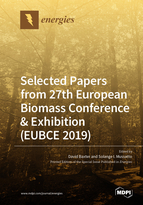Selected Papers from 27th European Biomass Conference & Exhibition (EUBCE 2019)
A special issue of Energies (ISSN 1996-1073). This special issue belongs to the section "A4: Bio-Energy".
Deadline for manuscript submissions: closed (29 February 2020) | Viewed by 56661
Special Issue Editors
Interests: bioenergy; bioliquids; heat and electricity; power; climate change; socio-economic impact; biomass conversion
Special Issues, Collections and Topics in MDPI journals
Interests: fermentation; biomass; biorefinery; biofuels; bio-based products; techno-economic analysis; life cycle assessment
Special Issues, Collections and Topics in MDPI journals
Special Issue Information
Dear Colleagues,
The European Biomass Conference and Exhibition Conference (EUBCE), 27th edition, held in Lisbon during 27–30 May 2019, is one of the world’s leading R&D conferences combined with an international exhibition. EUBCE represents the leading platform for the collection, exchange, and dissemination of scientific know-how in the field of biomass and its utilization.
The 2019 conference program addressed topics from biomass production, its conversion to bioliquids and biofuels for heat and electricity, transport, and bio-based products, covering all aspects of each value chain, from supply and logistics to conversion technologies, from the industrial application of research results to its impacts on the environment, from market and trade aspects to policy strategies, and last but not least to the role of biomass as a source in integrated energy systems.
Topics to be covered in this Special Issue include, but are not limited to, the following areas:
- Biomass feedstocks
- Agriculture
- Forestry
- Organic waste
- Bioenergy
- Energy carriers
- Biofuels
- Biorefinery
- Bioeconomy
- Climate change
- Sustainability
- Impacts
The submission of the excellent-quality papers in the aforementioned areas is highly encouraged. Please note paper should contain about 50% new content compared to the conference papers.
Dr. David Baxter
Dr. Solange I. Mussatto
Guest Editor
Manuscript Submission Information
Manuscripts should be submitted online at www.mdpi.com by registering and logging in to this website. Once you are registered, click here to go to the submission form. Manuscripts can be submitted until the deadline. All submissions that pass pre-check are peer-reviewed. Accepted papers will be published continuously in the journal (as soon as accepted) and will be listed together on the special issue website. Research articles, review articles as well as short communications are invited. For planned papers, a title and short abstract (about 100 words) can be sent to the Editorial Office for announcement on this website.
Submitted manuscripts should not have been published previously, nor be under consideration for publication elsewhere (except conference proceedings papers). All manuscripts are thoroughly refereed through a single-blind peer-review process. A guide for authors and other relevant information for submission of manuscripts is available on the Instructions for Authors page. Energies is an international peer-reviewed open access semimonthly journal published by MDPI.
Please visit the Instructions for Authors page before submitting a manuscript. The Article Processing Charge (APC) for publication in this open access journal is 2600 CHF (Swiss Francs). Submitted papers should be well formatted and use good English. Authors may use MDPI's English editing service prior to publication or during author revisions.







